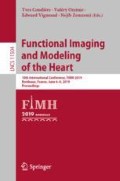Abstract
Image registration plays a very important role in quantifying cardiac motion from medical images, which has significant implications in the diagnosis of cardiac diseases and the development of personalized cardiac computational models. Many approaches have been proposed to solve the image registration problem; however, due to the intrinsic ill-posedness of the image registration problem, all these registration techniques, regardless of their variabilities, require some sort of regularization. An efficient regularization approach was recently proposed based on the equilibrium gap principle, named equilibrated warping. Compared to previous work, it has been formulated at the continuous level within the finite strain hyperelasticity framework and solved using the finite element method. Regularizing the image registration problem using this principle is advantageous as it produces a realistic solution that is close to that of an hyperelastic body in equilibrium with arbitrary boundary tractions, but no body load.The equilibrated warping method has already been extensively validated on both tagged and untagged magnetic resonance images. In this paper, we provide full validation of the method on 3D ultrasound images, based on the 2011 MICCAI Motion Tracking Challenge data.
Access this chapter
Tax calculation will be finalised at checkout
Purchases are for personal use only
References
Bornert, M., et al.: Digital image correlation. In: Grédiac, M., et al.: Full-Field Measurements and Identification in Solid Mechanics. Wiley, Hoboken (2012). https://doi.org/10.1002/9781118578469.ch6
Chabiniok, R., et al.: Estimation of tissue contractility from cardiac cine-MRI using a biomechanical heart model. Biomech. Model. Mechanobiol. 11(5), 609–630 (2012). https://doi.org/10.1007/s10237-011-0337-8
Christensen, G.E., et al.: Deformable templates using large deformation kinematics. IEEE Trans. Image Process. 5(10), 1435–1447 (1996). https://doi.org/10.1109/83.536892
Claire, D., et al.: A finite element formulation to identify damage fields: the equilibrium gap method. Int. J. Numer. Methods Eng. 61(2), 189–208 (2004). https://doi.org/10.1002/nme.1057
Finsberg, H., et al.: Efficient estimation of personalized biventricular mechanical function employing gradient-based optimization. Int. J. Numer. Methods Biomed. Eng. 34(7), e2982 (2018). https://doi.org/10.1002/cnm.2982
Genet, M., et al.: A novel method for quantifying smooth regional variations in myocardial contractility within an infarcted human left ventricle based on delay-enhanced magnetic resonance imaging. J. Biomech. Eng. 137(8), 081009 (2015). https://doi.org/10.1115/1.4030667
Genet, M., et al.: Equilibrated warping: finite element image registration with finite strain equilibrium gap regularization. Med. Image Anal. 50, 1–22 (2018). https://doi.org/10.1016/j.media.2018.07.007
Holzapfel, G.A.: Nonlinear Solid Mechanics: A Continuum Approach for Engineering. Wiley, Chichester (2000)
Krishnamurthy, A., et al.: Patient-specific models of cardiac biomechanics. J. Comput. Phys. 244, 4–21 (2013). https://doi.org/10.1016/j.jcp.2012.09.015
Leclerc, H., Périé, J.-N., Roux, S., Hild, F.: Integrated digital image correlation for the identification of mechanical properties. In: Gagalowicz, A., Philips, W. (eds.) MIRAGE 2009. LNCS, vol. 5496, pp. 161–171. Springer, Heidelberg (2009). https://doi.org/10.1007/978-3-642-01811-4_15
Logg, A., et al.: Automated Solution of Differential Equations by the Finite Element Method: The FEniCS Book. Lecture Notes in Computational Science and Engineering, p. 723. Springer, Heidelberg (2012). https://doi.org/10.1007/978-3-642-23099-8
Mansi, T., et al.: iLogDemons: a demons-based registration algorithm for tracking incompressible elastic biological tissues. Int. J. Comput. Vis. 92(1), 92–111 (2011). https://doi.org/10.1007/s11263-010-0405-z
Moireau, P., et al.: Joint state and parameter estimation for distributed mechanical systems. Comput. Methods Appl. Mech. Eng. 197(6–8), 659–677 (2008). https://doi.org/10.1016/j.cma.2007.08.021
Rausch, M.K., et al.: A virtual sizing tool for mitral valve annuloplasty. Int. J. Numer. Methods Biomed. Eng. 33(2), e02788 (2017). https://doi.org/10.1002/cnm.2788
Schroeder, W., et al.: The Visualization Toolkit: An Object-Oriented Approach to 3D Graphics, 4th edn, p. 512. Kitware Inc, Clifton Park (2006)
Sermesant, M., et al.: Patient-specific electromechanical models of the heart for the prediction of pacing acute effects in CRT: a preliminary clinical validation. Med. Image Anal. 16(1), 201–215 (2012). https://doi.org/10.1016/j.media.2011.07.003
Tobon-Gomez, C., et al.: Benchmarking framework for myocardial tracking and deformation algorithms: an open access database. Med. Image Anal. 17(6), 632–648 (2013). https://doi.org/10.1016/j.media.2013.03.008
Veress, A.I., et al.: Measurement of strain in the left ventricle during diastole with cine-MRI and deformable image registration. J. Biomech. Eng. 127(7), 1195–1207 (2005). https://doi.org/10.1115/1.2073677
Wang, H., et al.: Cardiac motion and deformation recovery from MRI: a review. IEEE Trans. Med. Imaging 31(2), 487–503 (2012). https://doi.org/10.1109/TMI.2011.2171706
Xi, C., et al.: Patient-specific computational analysis of ventricular mechanics in pulmonary arterial hypertension. J. Biomech. Eng. 138(11), 111001 (2016). https://doi.org/10.1115/1.4034559
Zou, H., et al.: Quantification of biventricular strains in heart failure with preserved ejection fraction patient using hyperelastic warping method. Front. Physiol. (2018). https://doi.org/10.3389/fphys.2018.01295
Author information
Authors and Affiliations
Corresponding author
Editor information
Editors and Affiliations
Rights and permissions
Copyright information
© 2019 Springer Nature Switzerland AG
About this paper
Cite this paper
Lee, L.C., Genet, M. (2019). Validation of Equilibrated Warping—Image Registration with Mechanical Regularization—On 3D Ultrasound Images. In: Coudière, Y., Ozenne, V., Vigmond, E., Zemzemi, N. (eds) Functional Imaging and Modeling of the Heart. FIMH 2019. Lecture Notes in Computer Science(), vol 11504. Springer, Cham. https://doi.org/10.1007/978-3-030-21949-9_36
Download citation
DOI: https://doi.org/10.1007/978-3-030-21949-9_36
Published:
Publisher Name: Springer, Cham
Print ISBN: 978-3-030-21948-2
Online ISBN: 978-3-030-21949-9
eBook Packages: Computer ScienceComputer Science (R0)

